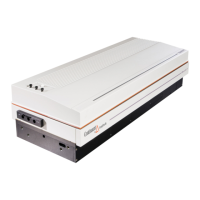Precision II Operation and Maintenance Manual
3-10
C
996-0255 rev. b
4) Active Q-switch
Principle of Operation
The Q-switch consists of the following:
Optical
a) Pockels cell
b) plate polarizing element
c) quarter-wave plate.
Electrical
a) timed pulse generated by control unit CU601C
b) Marx board (750 V)
c) 750 volt power board.
Pockels cell
The Pockels cell has a longitudinal field KD*P crystal with 15 mm clear
aperture mounted at 43 mm beam height. A voltage of ~3600 results in a
quarter wave of rotation for photons at 1.06 µm passing in either direc-
tion. A voltage of 0 volts results in no rotation.
Plate polarizer
The thin film multilayer dielectric polarizer has an angle of incidence of
57°. In its standard orientation, the polarizer is highly transparent (>95%)
to horizontal while being highly reflective (>99%) to vertical. The con-
trast/extinction ratio is >500:1.
Quarter-wave plate
The plate used introduces a quarter wave rotation to photons at 1.06 µ as
they pass in either direction through the plate. The plate has a clear
aperture of 15 mm and is mounted at a beam height of 43 mm.
Timed pulse generated by control unit CU601C
The control unit tracks the firing of the flashlamps in the laser head and
then at a preselected delay of ~200 µs triggers the Marx board with a +15
V pulse. The signal is normally set to fire at the peak of the gain curve of
the oscillator YAG rod.
Marx board (750V)
This board charges 7 capacitors in parallel and then discharges them
through fast switching transistors in series so that the voltage on each
capacitor is summed. This generates a ~3.6 kV pulse with a rise time of
20 ns. This board is in a metal box next to the Pockels cell.

